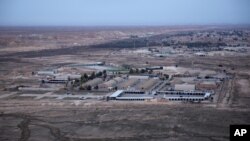ກອງກຳລັງຂອງສະຫະລັດ ຢູ່ໃນອີຣັກ ແລະຊີເຣຍ ໄດ້ຖືກໂຈມຕີດ້ວຍເຮືອບິນ ໂດຣນ ແລະຈະຫຼວດຢ່າງໜ້ອຍ 13 ຄັ້ງຕະຫຼອດນຶ່ງອາທິດທີ່ຜ່ານມານີ້ ອີງຕາມໂຄສົກທຳນຽບຫ້າແຈ ພົນຈັດຕະວາ ແພັດ ຣາຍເດີ ໄດ້ກ່າວໃນວັນອັງ ຄານວານນີ້ ໂດຍການຢືນຢັນລາຍງານກ່ອນໜ້ານີ້ຂອງວີໂອເອ.
ໃນການຕອບຄຳຖາມຈາກວີໂອເອ ທ່ານຣາຍເດີ ໄດ້ຖິ້ມໂທດໃສ່ພວກຕົວແທນ ທັງຫຼາຍທີ່ໄດ້ຮັບການໜຸນຫຼັງໂດຍອີຣ່ານ ສຳລັບການໂຈມຕີເກືອບວ່າທຸກວັນ ຕໍ່ກອງກຳລັງຂອງ ສະຫະລັດ.
“ພວກເຮົາຮູ້ດີວ່າ ພວກກຸ່ມຕ່າງໆທີ່ດຳເນີນການໂຈມຕີທັງຫຼາຍເຫຼົ່ານີ້ ແມ່ນໄດ້ ຮັບການສະໜັບສະໜູນໂດຍກອງກຳລັງພິທັກປະຕິວັດອິສລາມຂອງອີຣ່ານ ຫຼື IRGC ແລະລະບອບການປົກຄອງຂອງອີຣ່ານ. ສິ່ງທີ່ພວກເຮົາເຫັນແມ່ນຄວາມ ຄາດໝາຍສຳລັບການໂຈມຕີທີ່ທະວີຂຶ້ນຢ່າງຫຼວງຫຼາຍຕໍ່ກອງກຳລັງຂອງສະຫະລັດ ແລະບຸກຄະລາກອນ ຢູ່ທົ່ວຂົງເຂດໃນໄລຍະອັນໃກ້ໆນີ້ ທີ່ມາຈາກກອງກຳລັງຕົວແທນຂອງອີຣ່ານ ແລະໃນທີ່ສຸດຈາກອີຣ່ານ” ທ່ານຣາຍເດີ ໄດ້ກ່າວ.
ທ່ານກ່າວຕື່ມວ່າ “ຖ້າຫາກ ແລະໃນເວລາທີ່ພວກເຮົາຕັດສິນໃຈທີ່ຈະຕອບໂຕ້ ພວກເຮົາຈະເຮັດເຊັ່ນນັ້ນ ໃນເວລາ ແລະສະຖານທີ່ທີ່ພວກເຮົາເລືອກເອົາ.”
ການໂຈມຕີທັງຫຼາຍ ໄດ້ສົ່ງຜົນໃຫ້ມີຊາວອາເມຣິກັນ ຢູ່ຊີເຣຍ ໄດ້ຮັບບາດເຈັບ ເລັກນ້ອຍ ແລະພະນັກ ງານຢູ່ໃນອີຣັກອີກສີ່ຄົນ ກໍໄດ້ຮັບບາດເຈັບເລັກນ້ອຍ ທັງໝົດນັ້ນ ໄດ້ກັບຄືນໄປປະຕິບັດໜ້າທີ່ແລ້ວ, ເຈົ້າ ໜ້າທີ່ສະຫະລັດສອງທ່ານ ໄດ້ກ່າວຕໍ່ວີໂອເອ. ເຈົ້າໜ້າທີ່ອີກທ່ານນຶ່ງໄດ້ກ່າວຕື່ມວ່າ ກອງທັບໄດ້ສືບຕໍ່ຕິດຕາມເບິ່ງການບາດເຈັບຈາກການໂຈມຕີດັ່ງກ່າວ ທີ່ອາດຈະສົ່ງຜົນກະທົບຕໍ່ສະໝອງກໍເປັນໄດ້.
U.S. forces in Iraq and Syria have been attacked with drones or rockets at least 13 times over the past week, Pentagon press secretary Brigadier General Pat Ryder said Tuesday, confirming earlier VOA reporting.
Responding to a question from VOA, Ryder blamed Iranian-backed proxies for the near daily attacks on U.S. forces.
"We know that the groups conducting these attacks are supported by the IRGC [Iran's Islamic Revolutionary Guard Corps] and the Iranian regime. What we are seeing is the prospect for more significant escalation against U.S. forces and personnel across the region in the very near term coming from Iranian proxy forces and ultimately from Iran," he said.
"If and when we would decide to respond, we will do so at a time and place of our choosing," Ryder added.
The attacks have resulted in about 20 minor injuries to Americans in Syria and four minor injuries to American personnel in Iraq, all of whom have returned to duty, two U.S. officials told VOA. The military continues to monitor for any potential traumatic brain injuries caused by the attacks, one of the officials added.
One U.S. contractor at al-Asad Air Base in Iraq died after suffering a cardiac episode while sheltering in place during a false alarm for an air attack.
Attacks across bases
U.S. troops shot down two one-way attack drones targeting American forces at al-Tanf garrison in southern Syria on Monday, resulting in no injuries.
On Saturday, a one-way attack drone targeted al-Asad Air Base in western Iraq, resulting in no casualties or damage.
Three separate attacks occurred at al-Harir Air Base in northern Iraq on Friday, as U.S. and coalition forces were targeted with three one-way attack drones, resulting in no casualties or damage.
On Thursday, Iranian-backed militants targeted U.S. and coalition forces in four locations across Iraq and Syria. At Green Village, a Syrian Democratic Forces base in northeastern Syria that hosts coalition troops, U.S. forces shot down a one-way attack drone that resulted in no casualties. At Mission Support Site Euphrates in Syria, multiple rockets launched toward the base resulted in no damage or injuries. In Iraq, rocket attacks targeted forces at al-Asad Air Base and U.S. and coalition forces near Baghdad's International Airport, but neither resulted in casualties or damage.
Four additional attacks occurred on October 18, according to U.S. officials. Two drones targeted al-Tanf garrison in Syria during one attack. U.S. and coalition forces destroyed one drone, while the other drone reached the base and resulted in minor injuries to about 20 personnel, two U.S. officials confirmed to VOA.
U.S. forces in northern Iraq shot down another drone in the early hours of October 18 near al-Harir Air Base, formerly known as Bashur Air Base, resulting in no injuries or damage to coalition equipment or facilities. Two drones targeted al-Asad Air Base in two separate attacks on October 18; one was shot down and the other was damaged, resulting in minor injuries to coalition forces.
Ryder had said last week that these attacks occurred on October 17, but an official told VOA that he was referring to the time in Washington when they occurred, not the local time in Iraq.
US increasing protection in region
U.S. Defense Secretary Lloyd Austin on Saturday placed an undisclosed number of troops on prepare-to-deploy orders and activated the deployment of a Terminal High Altitude Area Defense battery as well as additional Patriot batteries to locations throughout the region to increase force protection for U.S. forces.
"What you see from this posture announcement … is that we are preparing for this escalation, both in terms of defending our forces and being prepared to respond decisively," a senior defense official told reporters Monday.
Austin had already placed more than 2,000 military personnel on heightened alert with a prepare-to-deploy order last Tuesday.
The USS Dwight D. Eisenhower carrier strike group is speeding to the Middle East region, and the USS Gerald R. Ford carrier strike group remains in the eastern Mediterranean.
Three ships with the USS Bataan amphibious ready group are positioning thousands of Marines in waters near Israel. A squadron of A-10 attack aircraft has arrived in the Middle East, with another A-10 squadron's deployment extended, and more F-15 and F-16 fighter jets also are rolling into the region.
The U.S. has said the increased military presence is intended to deter malign actors such as Hezbollah or Iran from expanding the conflict.
Last week, the USS Carney, a Navy destroyer in the Red Sea, shot down four missiles and multiple drones launched by Iranian-backed Houthis in Yemen, weapons that the Pentagon said were "heading along the Red Sea, potentially toward targets in Israel."
There were no casualties, and the ship did not appear to be the target of the attack, Ryder said.






